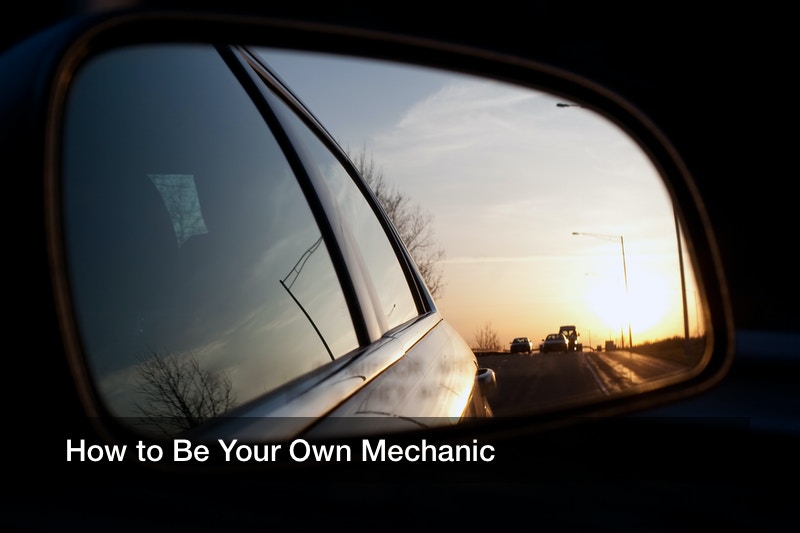

If you own a high-end car or recreational vehicle, you are probably familiar with the amount of maintenance these expensive toys require. However, you might not be aware of the money you could be saving by doing these repairs and maintenance yourself, especially after your warranty expires and the price of maintenance begins to skyrocket. Many of the repairs you thought could not do yourself can actually be done at home at a fraction of the cost with almost no expertise required. Here are some tips on how to be your own mechanic and save money on car and recreational vehicle repair and maintenance.
Most owners of expensive or high-end vehicles do not know enough about their cars to fix them on their own. With over 639,700 car mechanics in the United States, a professional garage may be necessary for a performance car tuning. However, many of the most costly auto repairs are surprisingly simple, straightforward, and can be done at home at a fraction of the cost. Here is how to be your own mechanic and get those expensive repairs done at home.
Changing the Battery
Based on their use, a car battery will generally need to be changed every four to six years. Many car batteries have an expiration date stamped on them or your vehicle will show you a low battery indicator when it is time to change it. Depending on the price and size or your vehicle, a new battery can cost anywhere from 50 to 200 dollars, although most dealership or repair shops will charge 200 to 500 dollars to change your battery. In this second scenario, the cost of service inflates the overall price. To be your own mechanic and save money, just disconnect the battery cables, making sure to disconnect the negative cables first. The rest of the process is as easy as removing the old battery, putting in the new one, and reconnecting the battery cables, making sure to reattach the negative cable last to eliminate any chance of short-circuiting the battery.
Repairing Chips in the Windshield

Occasionally a rock, stone, or other debris can scratch or chip even the most scratch-resistant or tough windshields. If you ignore this damage, it can weaken the overall strength and glass and end up costing you much more in replacement costs by a garage later on down the road, which may not be covered by your insurance. If you need a replacement while your car is in the shop, sports car rentals are a great option. However, it is much better to nip this problem in the bud early on and repair the chip or scratch. For this job, all you need to be your own mechanic is a windshield repair kit, which you can find online for 10 to 20 dollars. This task will only take about an hour if you follow the directions on the box. This will save you money, time, and an unnecessary trip to the repair shop later on down the road.
Changing the Air Filter
The job of your vehicle’s air filter is to filter the air that both heats and cools the inside of your car. Your vehicle’s filter catches any dust, pollutants, or other contaminants and prevents them from getting inside. Thus, your vehicle’s air filter is paramount to keeping the air inside your vehicle fresh and healthy. Although, after a certain amount of time, the filter will get dirty and need to be replaced. The first sign that your car filter needs to be replaced is that the vehicle will buck or shudder when the air conditioning or heat is turned on. The cost of a new air filter is about 15 to 30 dollars, yet repair shops and dealers charge around 150 to 250 dollars for a replacement. To be your own mechanic, just pop the hood of your car, open the air intake cover, and remove the old air filter. Then, you can install the new filter and put the cover back on.
Installing New Brake Pads
Changing your brake pads may not be a task for a novice, but most car owners with a general knowledge of their vehicle and its wheels will be able to complete this task. New brake pads cost only 20 to 40 dollars a set. Therefore, doing this maintenance yourself will save you a minimum of 200 to 300 dollars an axle. To be your own mechanic, you will need a jack stand for this job. With your vehicle in park, remove the lugs and then place the jack stand right under the jacking point of the car. Once the car is raised, there are many instructional videos and tutorials online to explain in detail how to install new brake pads. As previously mentioned, this task is not for a novice since removing and replacing the caliper requires some deftness.
Fixing A Dangling Exhaust
Driving on a bumpy road can cause your vehicle’s exhaust system to loosen and begin scraping on the road as you drive. If you hear any unexpected or unusual sounds while driving, you should always stop and inspect your car, keeping an eye on the backend to see if there is anything wrong with the exhaust system. However, always remember to wait until the car is cool to begin working on it. Usually, five to six hours is long enough to ensure the car has cooled down and is safe to work on.

If you can see that the exhaust pipe is loose or moving, the exhaust hangers likely need to be replaced. The good news is these cost about five dollars for one. To safely be your own mechanic, you will also need a jack stand to fix a problem with the exhaust. Once the car is jacked up, just clip off the broken hangers and install the new ones in their place. If you are injured during this process, contact an accident injury lawyer.
Replacing The Spark Plugs
Many cars manufactured today will not even need a spark plug replacement in their life span, but sometimes a sluggish ignition can cause the spark plugs to need replacing much quicker than usual. Though a new set of spark plugs might not cost more than 50 dollars, a garage or dealership may charge you in the range of 300 to 500 dollars depending on the model and make of your vehicle. If you want to be your own mechanic, start by looking at your owner’s manual to find out how many spark plugs your vehicle has and where they are located. Once you have done this, you can begin by removing the cover. Next, use a wrench to remove the old spark plugs and then install the new ones in their places.
Installing New Lights
Broken or flickering headlights could subject you to hundreds of dollars in traffic tickets and having a garage or dealership fix them may cost as much as 100 dollars. This is despite the fact that each bulb costs about 15 to 20 dollars. When buying new bulbs, refer to your old ones to ensure you are buying the same kind. To be your own mechanic and replace the headlight bulbs, access them through the engine compartment under the hood, not through the headlight cover. On the flip side, the tail light bulbs are replaced by removing the tail light cover. It is important that you never touch the bulb with your bare skin since oils in the skin can actually lessen its life span.
Changing the Windshield Wiper
Changing your windshield wiper blades is one of the easiest ways you can be your own mechanic. It is one of the simplest car maintenance tasks to do and dealerships and garages will still charge as much as 100 bucks to do it. A new set of windshield wiper blades costs about 20 to 25 dollars for the set and takes two minutes to install, with almost no skill required. Just loosen the clips, remove the old wiper blade by sliding it out, slide in the new one, and refasten the clips.
Changing The Oil
Changing your oil in your car is a bit more complicated than changing the windshield wiper blades for instance, and a lot messier. You will also need some tools, such as a drain pain. A garage or dealership will charge about 50 to 200 dollars for an oil change, depending on the make and model of your car. If you opt for a much cheaper oil change, they may be using low-quality oil that will be detrimental to your vehicle’s engine and performance. If you require a new engine, consider an aftermarket motor. If you be your own mechanic, you can choose the high-quality oil you want and eliminate any labor costs.
Removing Dents
The most common dent on a car occurs on the bumper, which is made of plastic. By pouring some boiling water on the bumper, the plastic will soften and you will be able to push it back out again with heatproof gloves or hands wrapped in towels. Scratches in the paint or dents in the metal body of your car will be a bit more labor-intensive to remove. However, car paint pens and suction cup dent removers can easily repair most of the damage.
Recreational Vehicle Repair Tips
On the other hand, recreational vehicle repair is not as simple as car repair because there are simply way more parts at play. Depending on the type of recreational vehicle you have, there are many different facets of the vehicle that will require maintenance or possibly need repairs, such as hydraulics, fuel injectors, refrigeration, fuses, slide mechanisms, sewer systems, and brakes. There are also many small parts in a recreational vehicle that may be hard to find, especially once the vehicle’s warranty has expired.

To find parts at a cheap price, try looking for repairable salvage vans for sale. Oftentimes, finding a credible mechanic who can fix your recreational vehicle for a reasonable price can be difficult, especially while out on the road. In this situation, you likely have to be your own mechanic. Here are some tips for recreational vehicle repair and maintenance.
An RV Repair Kit
Before you take your recreational vehicle out on a cross country adventure, you should assemble a repair kit for the road trip and keep it in a safe spot that is easy to access, either in the recreational vehicle itself or the tow vehicle if you have one. Just like aluminum cargo trailers, some recreational vehicles have to be towed. Make sure you have a copy of your proof of RV insurance in your tow vehicle and the RV itself. Your RV repair kit should also include roadside assistance plans and any contact information that is relevant to each policy, such as phone numbers, email addresses, or relevant policy numbers. The best way to store these documents is in a folder labeled “Contact Information.” This will make the process of getting your recreational repaired a lot less stressful.
Understanding Your Warranty and Service Plan
Your recreational vehicle’s warranty and service plan will vary drastically based on whether or not you bought it new or used, through a dealership, or if you bought it from someone who transferred the extended warranty into your name. Before you begin your road trip in your RV, you should know and understand what type of warranties were included with the purchase of your vehicle. Helpful services such as a technical support call center or an online technical chat are often included in many manufacturer’s warranties and extended service plans. If something goes wrong with your vehicle while you are out on the road, you can utilize these services to speak with someone over the phone or Internet who can help you troubleshoot and fix the issue.

This is why it is important to find out or double-check what warranties or service plans were included in your purchase of the vehicle. For new owners, many dealerships will include a free membership to a roadside assistance plan or access to a free troubleshooting hotline run by the dealership. After you know and understand what warranty and service plans were included in your purchase, you should policy and contact information to your RV repair kit.
Do It Yourself RV Repair
Fixing a recreational vehicle is not much different than fixing a car or a boat, although power for boats is slightly different. Having a boat might also require equipment such as life jackets, a navigation system, and dock building supply. There are many electrical components and working parts that make each system function. Some problems are easily fixed in minutes while others may take a few days and require some skill.
And of course, the last thing you need to be your own mechanic is a safe workspace. If your garage or shed doesn’t provide safe working conditions, then what’s the point in making a DIY repair attempt? For starters, make sure your home fire sprinkler design extends all the way to your garage. In addition, make sure someone else is within earshot at all times and that you have fire suppression equipment handy just in case something goes wrong.
Being your own mechanic can be a thrilling learning experience. So long as you’re safe and open to learning new things, you and your vehicles will be set for life.


